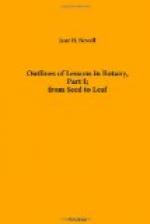[Footnote 1: Gray’s First Lessons, revised edition, 1887, page 42.]
2. Movements of Stems.—Let a glass thread, no larger than a coarse hair, be affixed by means of some quickly drying varnish to the tip of the laterally inclined stem of one of the young Morning-Glory plants in the schoolroom. Stand a piece of cardboard beside the pot, at right angles to the stem, so that the end of the glass will be near the surface of the card. Make a dot upon the card opposite the tip of the filament, taking care not to disturb the position of either. In a few minutes observe that the filament is no longer opposite the dot. Mark its position anew, and continue thus until a circle is completed on the cardboard. This is a rough way of conducting the experiment. Darwin’s method will be found in the footnote.[1]
[Footnote 1: “Plants growing in pots were protected wholly from the light, or had light admitted from above or on one side as the case might require, and were covered above by a large horizontal sheet of glass, and with another vertical sheet on one side. A glass filament, not thicker than a horsehair, and from a quarter to three-quarters of an inch in length, was affixed to the part to be observed by means of shellac dissolved in alcohol. The solution was allowed to evaporate until it became so thick that it set hard in two or three seconds, and it never injured the tissues, even the tips of tender radicles, to which it was applied. To the end of the glass filament an excessively minute bead of black sealing-wax was cemented, below or behind which a bit of card with a black dot was fixed to a stick driven into the ground.... The bead and the dot on the card were viewed through the horizontal or vertical glass-plate (according to the position of the object) and when one exactly covered the other, a dot was made on the glass plate with a sharply pointed stick dipped in thick India ink. Other dots were made at short intervals of time and these were afterwards joined by straight lines. The figures thus traced were therefore angular, but if dots had been made every one or two minutes, the lines would have been more curvilinear.”—The Power of Movement in Plants, p. 6.]
The use of the glass filament is simply to increase the size of the circle described, and thus make visible the movements of the stem. All young parts of stems are continually moving in circles or ellipses. “To learn how the sweeps are made, one has only to mark a line of dots along the upper side of the outstretched revolving end of such a stem, and to note that when it has moved round a quarter of a circle, these dots will be on one side; when half round, the dots occupy the lower side; and when the revolution is completed, they are again on the upper side. That is, the stem revolves by bowing itself over to one side,—is either pulled over or pushed over, or both, by some internal force, which acts in turn all round the stem in the direction in which it sweeps; and so the stem makes its circuits without twisting."[1]




